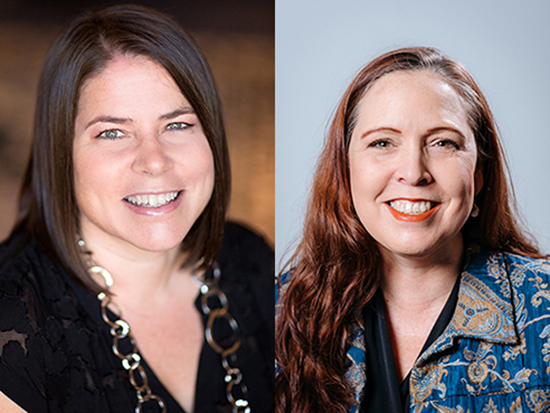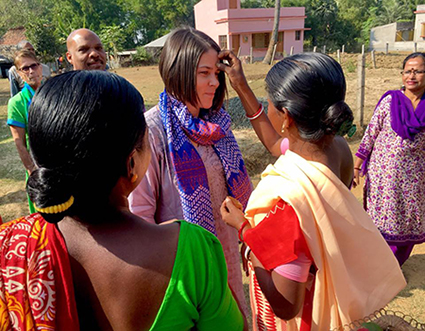Media contact: Yvonne Taunton
 Colleen Fisher, Ph.D., will examine microfinance to alleviate poverty among vulnerable women in low-resource countries, and Cathleen Cummings, Ph.D., will study and map temples from the Bhosle dynasty of Nagpur, India.Two associate professors from the University of Alabama at Birmingham College of Arts and Sciences have received Fulbright-Nehru awards to pursue separate research projects in India. Colleen Fisher, Ph.D., associate professor of social work, and Cathleen Cummings, Ph.D., associate professor of art and art history, will travel to India in 2022 due to COVID-19 travel restrictions.
Colleen Fisher, Ph.D., will examine microfinance to alleviate poverty among vulnerable women in low-resource countries, and Cathleen Cummings, Ph.D., will study and map temples from the Bhosle dynasty of Nagpur, India.Two associate professors from the University of Alabama at Birmingham College of Arts and Sciences have received Fulbright-Nehru awards to pursue separate research projects in India. Colleen Fisher, Ph.D., associate professor of social work, and Cathleen Cummings, Ph.D., associate professor of art and art history, will travel to India in 2022 due to COVID-19 travel restrictions.
India is a unique place to conduct my research, Fisher says.
“Many women in India live in extreme poverty, have no formal education and were raised to work within the home, which is problematic on many levels — especially when the death of a spouse or divorce places the woman as head of the household,” Fisher said.
Women who are trained through social norms to be stay-at-home mothers now must provide for their children with no job skills or other training –– a situation in which two bad conditions exist simultaneously. According to Fisher, microfinance — a nonconventional intervention that targets people who lack access to traditional banking and financial services — could be a solution for women in those circumstances. Her Fulbright-funded research will explore those possibilities.
Fisher is approaching the issue from the perspective of social work rather than an economic, business or managerial focus. It is a relatively new approach to the field, she says. The current research on microfinance options for women in India typically tracks loan-repayment status or income growth. Still, few questions are being asked about their lived experience with microfinance, the empowerment they gained from it, or whether their literacy skills and health improved.
“There are so many ripple effects microfinance can have on women’s lives,” Fisher said. “There’s been almost no qualitative research, which we need to understand women’s lived experiences for women to have a voice in the process.”
Fisher will work alongside women using microfinance to develop a data collection instrument called a life history calendar. Unlike with a quantitative survey or interview comprising static questions, Fisher will work with the women to establish the instrument using both symbols and words, which will help women unable to read or write. In addition, Fisher will work as the photographer and shoot portraits of the women to illustrate their journeys.
“I want to contextualize that poverty doesn’t look the way people think,” Fisher said. “These women are beautiful and proud, and I will try to take photos that highlight that.”
Because of the COVID-19 pandemic, Fisher does not know exactly when she will travel to India; but she expects to stay there for about five months total during two separate trips. She also is the program director for the Master of Social Work program and hopes to use her time in India to form study-abroad partnerships for UAB students.
Cummings plans to study temples from the Bhosle dynasty of Nagpur, India, in the 18th and 19th centuries and later, which generally have been neglected by art historians and scholars, with great consequence, she says. Many have been torn down, left in disrepair, or converted into other uses, often with little to no record of their existences — which makes her work time-sensitive, she says.
 Cummings plans to map every temple and sacred complex she can find. Unfortunately, there is no comprehensive record of the temples still standing, and many temples are in private hands. For example, all that remains of one particular temple she will map is an inner shrine that sits inside the car park on the ground floor of an apartment complex.
Cummings plans to map every temple and sacred complex she can find. Unfortunately, there is no comprehensive record of the temples still standing, and many temples are in private hands. For example, all that remains of one particular temple she will map is an inner shrine that sits inside the car park on the ground floor of an apartment complex.
“The temple was privately owned, and the family could make money by converting the area into a block of flats,” Cummings said. “They kept the inner part of the temple but nothing else.”
Cummings plans to study structures that were built using a mix of brick, wood and tile and are vulnerable to the elements over time. She says one temple owner unwittingly attempted to preserve the historical structure and covered a leaking timber roof with concrete, only to discover that the wooden pillars could not support the weight of the concrete. As a result, he has no more resources to dedicate to the project.
“Many of these structures are under threat, and we need to document them as best as possible,” Cummings said. “And then we need to publicize them as much as possible with the idea of raising awareness and hopefully preserving them.”
Cummings will work to contextualize the temples to British colonialism and Orientalist scholarship. The temples represent an understudied and significant corpus of Hindu architecture and sculpture and provide a case study for understanding dynamics between the British and various Indian states in the 18th century.
Cummings hopes to turn her research into a book documenting the existing temple architecture and chronicling the era’s history.
“There are 1.4 billion people in India, so a huge percentage of our world are Indians,” Cummings said. “It’s important to understand the rest of the world. If you dive in and look carefully, you can learn so much about history and culture and people and what they believed in, what was important to them, just by looking at what they made and cherished.”